May 20th, 2010
Two months ago, I tore down the Riparium that was in my 20H, and replaced it with a more traditional aquascape. I was using it as more of a practice aquascape in advance of an aquascaping demonstration I was giving at the time, rather than an earnest attempt at producing the best scape ever. Despite not fitting that description, I’m rather pleased with how it’s shaping up.
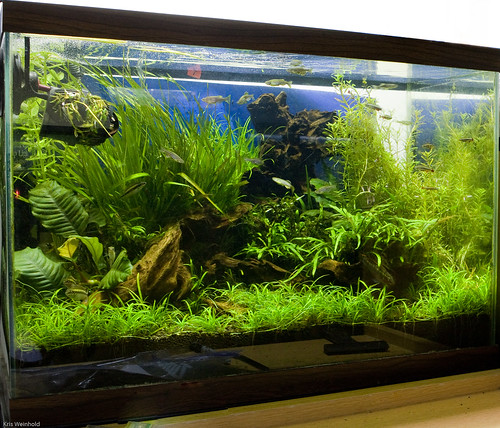
For starters, I’ve always been more successful with larger aquariums in the 40G-75G range, while the 10-20G aquariums never seemed to return the results I was looking for. I think I’ve finally managed to balance out the lighting, CO2, and dosing for this 20H as I don’t have any algae, and the plants are looking really good. I had some initial problems where the plants were melting, but after raising up my metal halide light and adjusting the fan, I think I can attribute that problem to excessive heat.
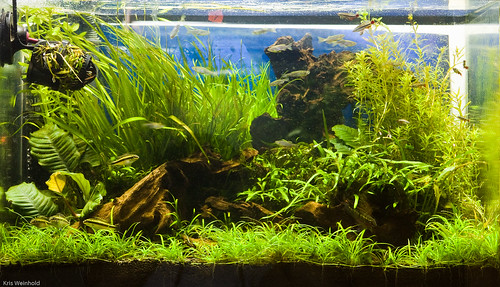
I’m housing some Super Red Kribs in here along with some white clouds and zebra danios. A few of these fish will likely end up out in my pond for mosquito control very soon. The Ranalisma rostrata has nearly filled in the foreground. The Blyxa aubertii is contantly sending up flowers, and the Bacopa sp. ‘Araguaia’ is poking out of water surface. Comments/critique welcome!
Posted in 20G High Tank Log, Aquascaping | Comments Off on 20H – Filling in, Growing Nicely
March 16th, 2010
This weekend I decided to rescape my 20H aquaruim. Previously, I had been running this as a Riparium, but while I really did enjoy setting up the Riparium, I was ready to go back to a more traditional aquascape. In addition, I am doing a 20H aquascaping demonstration this weekend, and was told that I would have bogwood to use, so I wanted to practice a little bit in these dimensions.
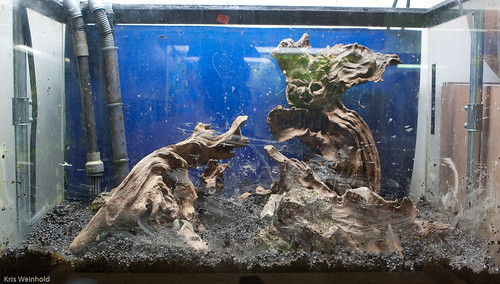
I started by setting up the hardscape using a combination of African bogwood and slate. I was going for a large broken root system look in some form of a loose mound setup.
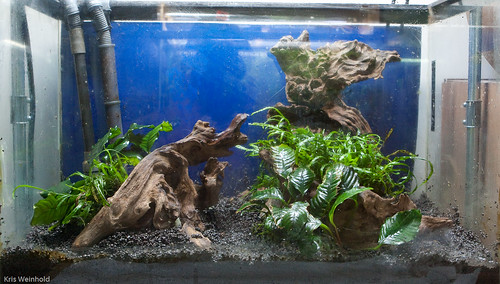
I also wanted to keep this aquarium somewhat low-tech using plants I had on hand, so I pulled out some standby Trident Java Fern, Anubias barteri var. ‘coffeefolia’, and assorted Cryptocoryne.
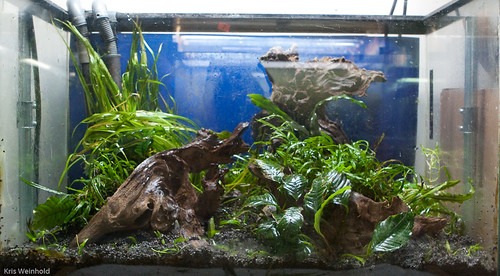
In the foreground I placed Ranalisma rostrata, and in the background I used Blyxa aubertii and Rotala sp. ‘Hra’. Of all of the plants in this tank, I would probably replace the Anubias with a smaller nana or petite variety, as the coffeefolia is a little bit too large. I should also probably tie some moss to the wood to make it a little bit softer.
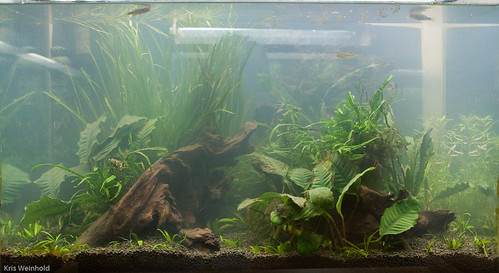
Above is the aquarium shortly after filling it up. It’s definitely not the best aquascape I’ve ever done, but for simply toying around for a little while, I’m not too disappointed with it. Comments welcome!
Posted in 20G High Tank Log | 4 Comments »
January 5th, 2010
It’s been a little while since I’ve talked about my Riparium, but it’s been doing fairly well as of late. The biggest improvement has come after I suspended a 4x24W T5 + 250W MH pendant overtop of the tank, which used to light up my old 54G aquarium. This fixture is definitely overkill, but the plants, particularly the terrestrial ones, have really responded growing up above the rim of the 20-high. I’ve started dosing some ferts in this tank also, as I believe the aquasoil has run out. That, and since I added more light, I needed to make sure I balanced that with proper plant nutrition.
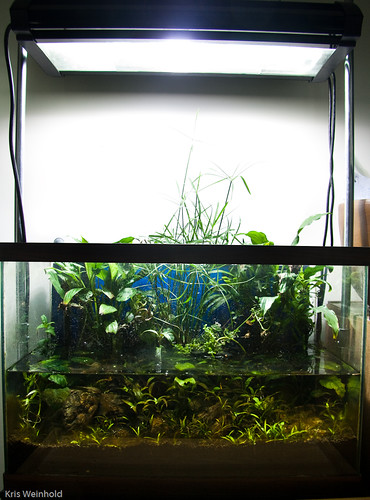
The Zebra Danios are still doing well in this tank, but my favorite fish in here are a pair of Rainbow Darters that I got in the Aquafest auction. They’re really odd, but strangely personable fish, that I feed frozen or live foods directly from a pair of tweezers. When I come into my fish room, they will often skirt right up to the glass and watch me, anticipating being fed.
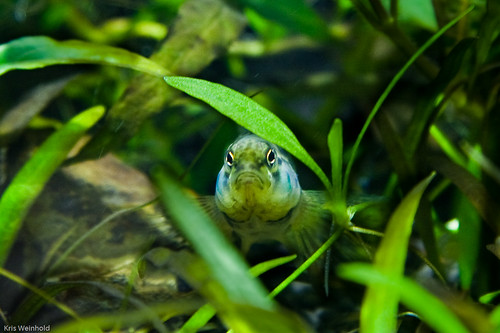
I feed them via tweezers to ensure that they get fed, as they are not nearly as quick as the danios in the tank. As for the Riparium Supply equipment, I haven’t had any problems. All of the suction cups are still holding everything in place, and the plants anchored in the plastic cups are growing well.
Posted in 20G High Tank Log | 10 Comments »
October 27th, 2009
The Zebra Danio is one of the fish that has been in the hobby forever. They are commercially bred and are available for sale in virtually every pet store, commonly being one of the first fish people keep when entering the hobby. For this reason, they are easily overlooked by more seasoned hobbyists when choosing inhabitants for their aquarium. This spring, the temperatures outside were still chilly, but I was beginning to see mosquito larvae outside in my pond. I went to my favorite fish store, and asked the owner what he suggested for a reasonably cold-tolerant fish that would provide mosquito protection, and he suggested the Zebra Danio.
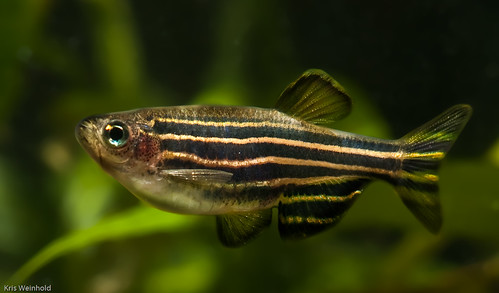
For all of the reasons I mentioned above, I was hesitant, but the price was right (less than $.99/fish) so I came home with a dozen fish. They cleared out the mosquito larvae problem nearly overnight, and were quite active in the pond. Also, outside in the full sun, I noticed far more colors than their typical brown and tan zebra stripes. Flashes of blue or green iridescence showed up, as well as, yellow on the tops of their fins. Before long, I noticed lots of small fry swimming outside in the pond. My dozen fish had easily tripled, if not more.
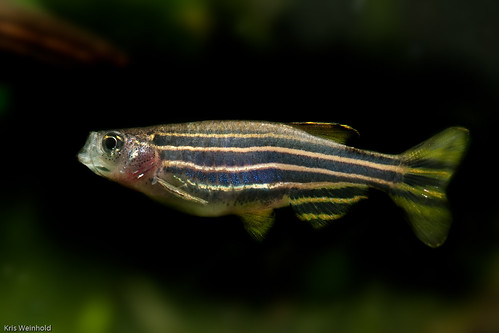
When fall came, and the nighttime temperatures began to decline again, I brought the danios inside and placed them in a riparium/terrarium setup that I have going. I thought they would like the extra water flow I have in that particular aquarium, and so far they don’t seem to have any complaints. They are probably the best schoolers and most active fish I’ve kept in a planted aquarium. They might stress more calm/docile tank mates, but they are fun to watch as they never stop schooling from one side of the tank to the other. If you’re looking for an inexpensive schooling fish for your planted aquarium, you really can’t go wrong with the Zebra Danio.
Posted in 20G High Tank Log, Fish Profiles | 5 Comments »
April 28th, 2008
The Jewel Cichlids from Florida are at it again! Last week, I had a cloud of fry, with a dozen or two remaining today, but nevertheless the parents are protecting them. The fry spend much of there time combing through algae on the manzanita wood in the tank. If they ever venture too far away, the parents suck them in their mouth, and bring them back “home.”

And of course, the bonded pair are acting like psycho parents toward the other two Jewels in this tank. Fortunately, all of the cichlids have plenty of hiding spots, and are roughly equal size, so no one has gotten injured. That hasn’t stopped the parents from lording over 2/3’s of the tank, however.
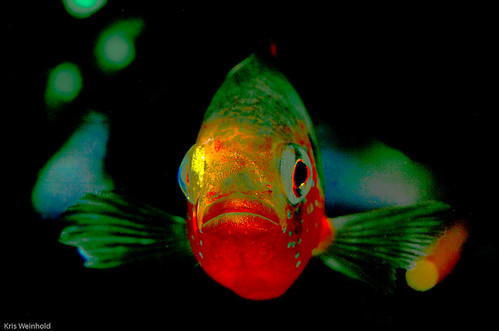
Despite being beautiful fish, I don’t really want anymore, so I’m not deterring much from my usual feeding routine with this batch of fry. I’ve added an occasional feeding of hatched brine shrimp and egg solution, but mostly I’m letting them fend for themselves. If a handful grow up, that’s great, but if not, I’m sure they’ll have more babies soon enough.
Posted in 20G High Tank Log, Fish Fry | 2 Comments »
February 11th, 2008
I’ve largely neglected my 20H for some time. At first, I had 55W over this tank, and was constantly frustrated with algae problems. Eventually, I got sick of it, and went with a 15W fluorescent strip light over instead. Since then, the algae has been dying back, but I’ve been surprised by some of the plants that have hung on.
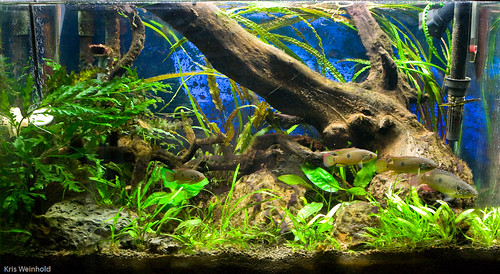
The Ranalisma rostrata has kept growing, albeit differently, the bolbitus has grown leaps and bounds, and my crypts have done just fine. Most surprising is the Eriocaulaceae sp. ‘Type 2? that’s continued to grow despite the awful light. Inspired by this, last weekend I pulled a few more crypts/anubias from my 54G corner tank, and filled in some of the gaps in the layout. The picture above is the result of that effort.
This isn’t a typical aquascape, but somehow it looks more natural to me then some of the others. The Jewels seem to be right at home with the plants. I’d love to hear any comments you might have on the scape.
Posted in 20G High Tank Log | 14 Comments »
September 21st, 2007
Ever since I setup this tank, I’ve been fighting terrible algae throughout. The wood constantly recovered itself with new hair and black brush algae. I would scrub it off with a toothbrush every couple of days, and back it would come.

I’ve had thread algae, staghorn, BGA, you name it in here. I’ve always been adding CO2, but it must not have been enough to thwart off the black brush algae. I finally resorted to chemicals, by overdosing Seachem Excel by several times the normal recommended amount. Combining that an extensive cleaning of both the glass and ornaments, and adding a hang-on Mag filter for more circulation I think the tide is finally turning. I’ve also added in more plants to out-compete the algae for nutrients. Hopefully I’ll soon be able to work on the aquascape without worrying about algae ruining everything.
Posted in 20G High Tank Log, Algae | 5 Comments »
September 7th, 2007
I noticed today that my adult jewel cichlids, collected in Florida, were acting more territorial than usual to their last set of offspring in the tank. Those young are now all 1-2 inches in length, and doing quite well. The adults, however, seem to have moved on, and are guarding a new patch of eggs.
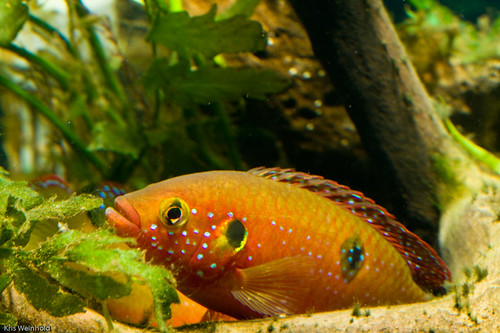
They’ve taken a new spot this time, occupying the left side of my 20G high tank, underneath a manzanita branch. There are eggs scattered on the underside of the manzanita branch, but mostly on the surface of the rock directly beneath that.

The parents take frequent turns guarding and fanning the eggs. I probably spent a collective hour watching them today, and their rotation is really only about 1-2 minutes before the one roaming the tank comes back to the nest, switching places with the other one. That said, the female does seem to spend more time guarding the nest while the male patrols, but not by too much.

I suppose this means that I ought to move the previous fry from this tank into their own dedicated one before the eggs hatch. If there are new free-swimming fry, I fear that the last batch will be eliminated by the parents.
Posted in 20G High Tank Log, Fish Fry | 1 Comment »
June 28th, 2007
I recently spent a long weekend at the beach, and when I returned home, two of the Jewel Cichlids that I had collected while in Florida had paired up, spawned, and were now rearing a some cloud of fry. Before I left, two of the four fish were obviously pairing up. They started showing magnificent coloration, guarded a cave under a large manzanita root, and were making life hell for the other two Jewels in the 20G high that they were in.

I spent the better part of 3 evenings before I left attempting to fish out the two other Jewel cichlids. I successfully netted one of them, and he now occupies a tank by himself. The other one was far too quick for me, but unfortunately, not quick enough for the pair, as when I returned, they had sealed the loner’s fate. Having the tank to themselves, the male and female take turns guarding their fry. But they still have no qualms leaving their babies when I feed them black worms, as they nearly jump from the water to snatch the worms.

It’s nearly impossible to count how many fry are present, but extrapolating from what I was able to count, I’d estimate that I have 100-150. If even half of that number survive, I’m going to be flooding the market with some very pretty Jewel Cichlids at CCA meetings later this year. So far, I’ve been relatively satisfied with their interactions with plants in the tank. A few sprigs of Blyxa japonica have been uprooted, but those were right next to their spawning site. Otherwise, they haven’t caused too much damage.

Posted in 20G High Tank Log, Fish Fry, Florida | 10 Comments »
May 11th, 2007
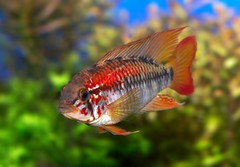
RIP apistogramma viejit |
As posted a couple days ago, I rescaped my 20G high tank with some fresh Amazonia aquasoil and manzanita wood. I’ve rescaped a number of tanks in the past with aquasoil, and I’ll usually add the soil, plant and scape the tank, fill with water, allow to cycle for a few hours, and then add in the fish. Most times, the filters are preexisting, or some of the plants/hardscape come from other tanks, so the biological filter should be largely pre-established. I’ve never had any problems with fish loss using this method.
Now I’ve read and heard about other folks experiences about how new aquasoil temporarily causes the pH to crash. Since my methods above have always worked, I’ve never paid them much heed. True, the pH does drop, but never to an extreme degree that the fish couldn’t adjust to. So, with this 20G setup, I followed my same methodologies. I removed the apistogramma viejitas that were in there, placed them in a bucket with airstone, and proceeded with the change. A few hours after setup, I moved the apistogramma back into the tank. I was actually hoping that the pH would drop down a fair amount and induce spawning since I haven’t been able to get them to breed at a 6.5 CO2 induced pH. They seemed happy enough that night. Morning came, and they were still swimming around, not looking distressed. Then, I get home from work, and one is on the floor, and the other is upside-down in the tank. What changed?
Well, I’m not sure. This is the first tank I’ve setup with fresh wood in a long time. Is it possible that the tannins from the new manzanita dropped the pH further in conjunction with the aquasoil-induced drop? I don’t know. In any case, I think I’ll let my fish spend an extra day or two in an aerated/filtered bucket next time I redo a tank with aquasoil. Rest in peace apistogramma viejita.
Posted in 20G High Tank Log | 3 Comments »




















